The Spiritual Landscape: Exploring Pilgrimage Sites in Ireland and Beyond
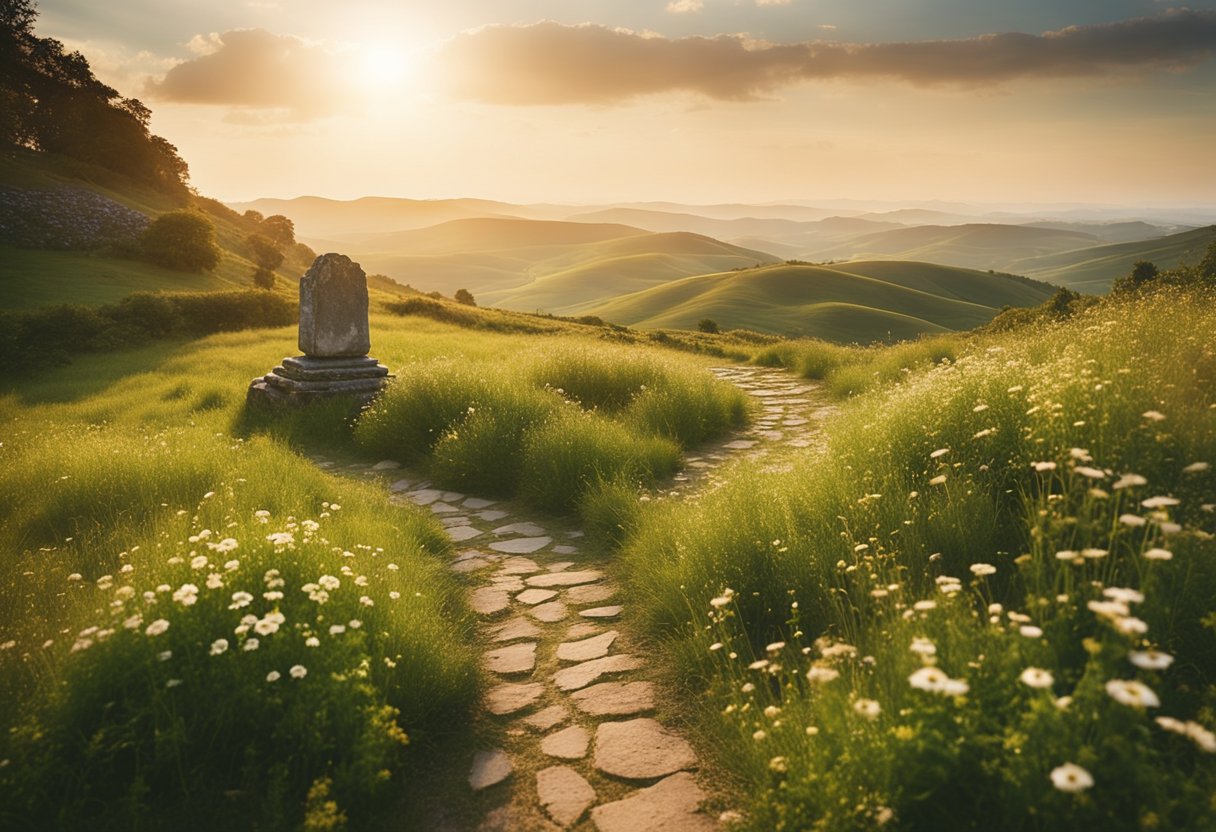
Updated On: April 22, 2024 by Eman Sameh
Pilgrimage sites in Ireland have long been a staple of spiritual and cultural life, offering a unique blend of religious devotion, heritage, and natural beauty. Ireland’s pilgrimage tradition is rooted in its history, where the rugged landscapes and ancient sites have significantly shaped the nation’s identity. Modern pilgrims to these sacred sites walk in the footsteps of countless others, tracing paths that have been travelled for centuries, seeking spiritual growth, healing, and a connection to their past.

These sacred journeys are not confined to Ireland alone; they are part of a global tapestry of pilgrimage practices. The Camino de Santiago, for example, is a testament to the universal appeal of such spiritual quests, drawing people from all walks of life to traverse vast distances in the spirit of reflection and discovery. Whether in the green fields of Ireland or along the storied routes of the Camino, pilgrims navigate landscapes imbued with a sense of the sacred, gathering experiences that bridge the physical and transcendent realms.
Within Ireland, as seasons change, so do the pilgrimages, with various festivals and commemorative events marking the calendar. In an ever-changing world, these practices offer continuity, binding the present to a storied past and a shared heritage. Preserving these traditions is not only about maintaining cultural identity; it’s also about understanding and celebrating our collective human journey through the lens of faith, history, and the indelible marks they leave upon our landscapes.
History of Pilgrimage sites in Ireland
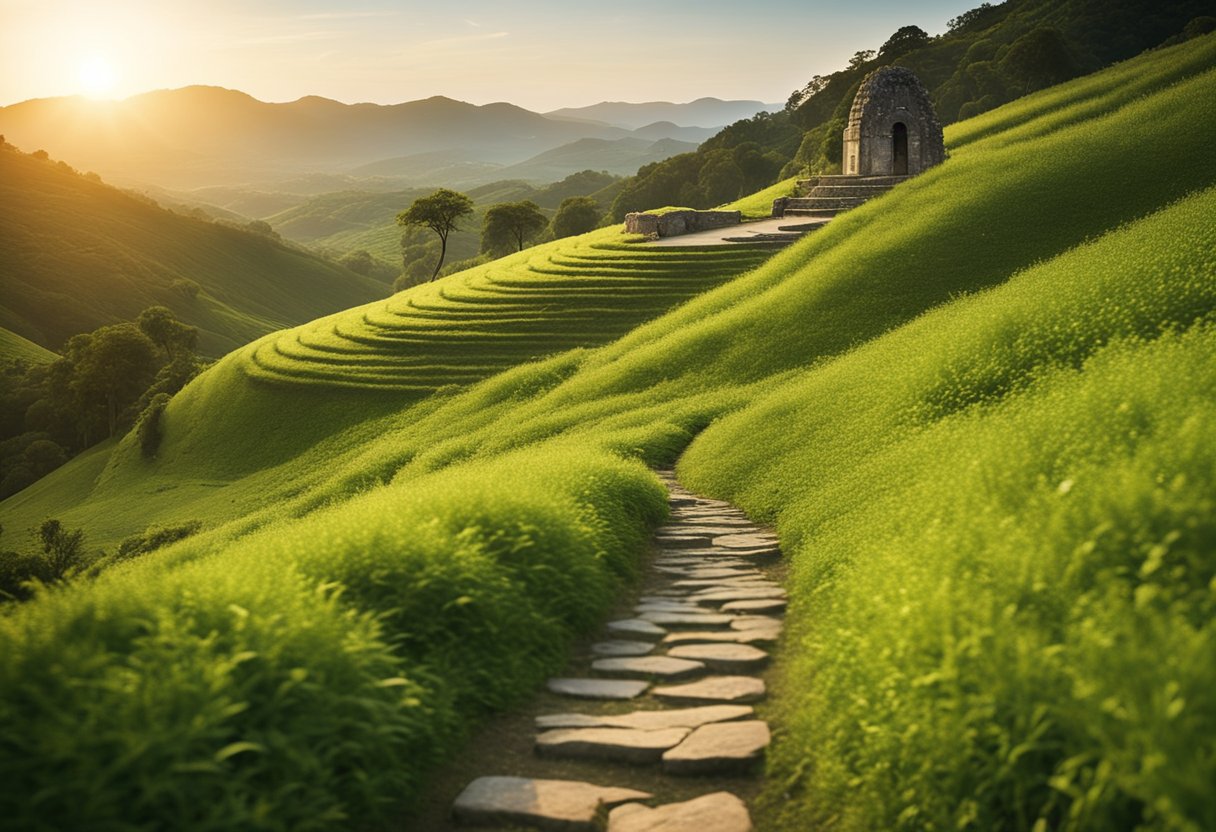
Before we delve into the early spiritual journeying in Ireland, it’s crucial to acknowledge the deep-seated religious fervour and rich traditions that have paved the way for sacred pilgrimages. These ranged from the pursuit of spiritual enrichment to the seeking of penance and miraculous cures.
Early Christian and Celtic Traditions
Irish pilgrimages have their origins intertwined with Celtic spirituality and the Early Christian era. The Celts, with their profound reverence for nature and their belief in the interconnectedness of life, greatly influenced the spiritual practices of Ireland. With the arrival of St. Patrick and the subsequent introduction of Christianity, an enigmatic fusion of Christian and pagan practices emerged. This led to the sanctification of natural sites, already held in esteem by the Celts, which began to serve as destinations for Christian pilgrimage.
Pilgrimage in the Celtic era embodied a journey not only to sacred places but also represented an inner spiritual voyage. The concept of ‘peregrinatio pro Christo’, or wandering for Christ, was a hallmark of Irish monasticism, leading individuals to renounce their attachments to wander in search of spiritual closeness to God.
The Emergence of Pilgrim Paths
During the Celtic era, an infrastructure for pilgrimage gradually developed, seeing the creation of defined pilgrim paths of Ireland. One of the most renowned of these is the path to Croagh Patrick, named after St. Patrick, who is said to have fasted there for forty days. The Catholic Church played a pivotal role in establishing these routes, creating a network that gave spiritual travellers direction and purpose. Over time, these paths became infused with stories of saints and scholars, enhancing their sacred significance to both early Christians and those who yearn for a deeper connection with Irish spirituality.
Through these established pilgrim paths, individuals could undertake journeys that might lead them towards personal transformation and a deeper understanding of their faith. This connection between the Catholic Church and the establishment of pilgrim paths ensured that these routes of spiritual quest would become an enduring part of Ireland’s religious landscape.
Iconic Pilgrimage Sites in Ireland
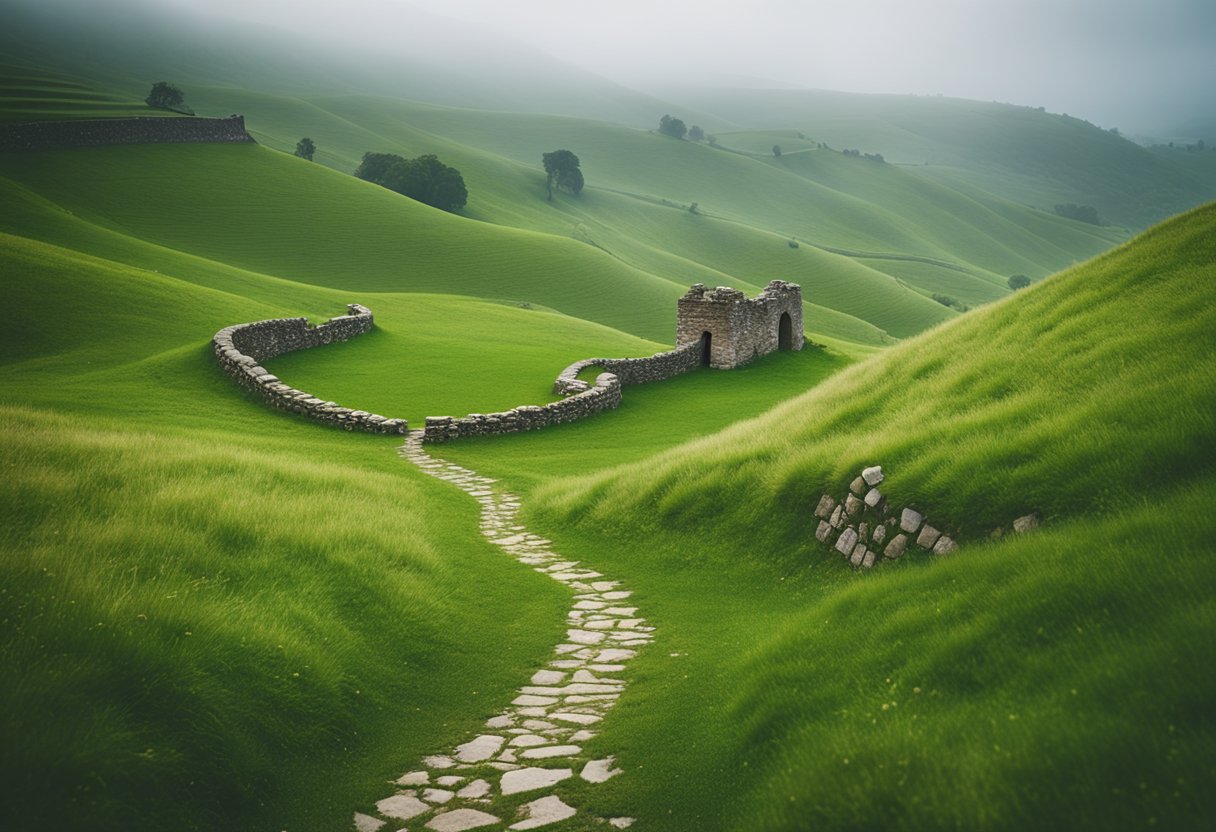
Ireland’s spiritual terrain is dotted with sites of significant religious importance, offering pilgrims a journey through both serene landscapes and rich history.
Croagh Patrick: The Holy Mountain
Croagh Patrick, renowned as ‘The Holy Mountain’, is a testament to Ireland’s enduring faith. This sacred mountain is situated in County Mayo and is linked with St. Patrick, Ireland’s patron saint. Each year, thousands ascend the mountain, especially on the last Sunday in July, known as Reek Sunday, to continue a centuries-old tradition of pilgrimage.
Lough Derg: The Penitential Island
The Lough Derg Pilgrimage is one of Ireland’s oldest ongoing spiritual quests situated on Station Island. Known for its rigorous three-day fast, the pilgrimage to this ‘Penitential Island’ offers an opportunity for reflection and repentance, deeply rooted in the Christian tradition.
Glendalough: The Monastic City
Nestled in the heart of the Wicklow Mountains, Glendalough or ‘Valley of the Two Lakes’ is a monastic settlement that dates back to the 6th century. Its tranquil natural surroundings and impressive round tower are beacons that drew religious scholars and devout pilgrims alike, seeking solitude and wisdom.
Ballintubber Abbey: The Living Pilgrimage
Standing resilient for over 800 years, Ballintubber Abbey in County Mayo, often called ‘The Abbey that refused to die’, continues to hold daily Mass. As the starting point of the ancient pilgrim route to Croagh Patrick, it has welcomed pilgrims without interruption since its foundation in 1216.
Through embracing these enduring monuments to spirituality, we walk in the footsteps of countless pilgrims who have sought solace and connection within Ireland’s hallowed landscapes.
Pilgrimages Beyond Ireland: The Camino de Santiago
Embarking on the Camino de Santiago is not merely a trek but a journey steeped in history where modern pilgrims from Ireland and around the world converge to continue a tradition that spans centuries.
St. James’s Way: A Cross-Cultural Experience
The Camino de Santiago, known in English as the Way of St. James, is an intricate network of routes leading to the shrine of the apostle St. James in the cathedral of Santiago de Compostela, Spain. As a UNESCO World Heritage Site, the Camino draws an annual footfall exceeding 300,000 pilgrims. It embodies a unique cross-cultural experience, connecting paths from various European countries that all converge in northwestern Spain. This multitude of routes caters to various forms of travel, whether on foot, by bike, or even on horseback, making it accessible for a diverse array of pilgrims, each choosing their own manner to embark on this spiritual adventure.
Reflections from Irish Pilgrims Abroad
Irish pilgrims venturing on the Camino de Santiago often reflect on a profound connection to their own historic pilgrim routes back home. Many find parallels in the sense of community, spiritual enrichment, and the physical challenge accompanying such a pilgrimage. Pilgrims undertake this path on what is often a deeply personal journey, yet also share in the collective fabric that makes the Camino de Santiago a global phenomenon. From a backpacking enthusiast looking for a new challenge to those seeking reflection and peace, the Camino continues to resonate with individuals from Ireland and beyond.
The Spiritual and Physical Journey

The intertwining of hiking and spiritual practices forms a core part of pilgrimages in Ireland. Participants engage in a physical journey that mirrors their spiritual quest, often finding that the act of moving through landscapes is a form of worship in itself.
Hiking as Worship
We see hiking as not just a physical activity but also a deeply spiritual exercise. The act of traversing the verdant landscapes of Ireland, like the age-old route to Skellig Michael, allows worshippers to connect with the divine through nature’s untouched beauty. Footsteps echo the rhythm of prayer, becoming meditations in motion as the path unwinds before them.
Rituals Along the Path
As pilgrims tackle the undulating terrains of holy sites such as Croagh Patrick, they often engage in rituals that enhance their spiritual experiences. These rituals range from reciting ancient prayers at dedicated stations to observing moments of silence that allow the soulful ambience of the path to infuse their being. Each custom is steeped in history, cultivating a connection to the generations of pilgrims who have walked these paths before them.
Landscape and Sacred Spaces
In exploring Ireland’s spiritual landscape, we appreciate the profound relationship between the physical environment and the sanctified places within it. This nexus of geography and spirituality manifests through natural settings and human-crafted sacred spaces, each holding a unique place in the cultural and religious tapestry of the land.
Natural Sanctuaries
Ireland’s natural sanctuaries, such as the Wicklow Mountains and Clew Bay, form an integral part of the ritual landscape. These natural formations are not merely scenic; they are imbued with a history of spiritual significance. With their serene beauty and secluded wilderness, the Wicklow Mountains have been a source of inspiration and solace, offering a tranquil backdrop for contemplation and reflection. Meanwhile, Clew Bay, with its remarkable vistas, is a tapestry of nature’s artistry that has been revered as a sacred site, hosting pilgrims who traverse its terrain in a quest for spiritual fulfilment.
- Wicklow Mountains: A haven for reflection.
- Clew Bay: Historical significance in pilgrimages.
Constructed Places of Purity
Historic religious structures interspersed across these landscapes serve as constructed places of purity. These sites, where ancient stones whisper tales of devotion and echoes of ancestral prayers mingle with the wind, provide an unparalleled glimpse into the spiritual practices of past generations. The crafted alignments with the natural world around them showcase a harmony between human intention and nature’s grandeur. For example, megalithic sites like the Drombeg Stone Circle, often found nestled in the rolling hillsides or perched on rugged coastline edges, capture the seamless blend of environment and spirituality.
- Megalithic Sites: Standing stones that converge the natural and the sacred.
- Churches and monasteries: Architectural dedications to faith across Ireland’s landscapes.
Modern Pilgrimage Practices

In exploring how pilgrimages maintain their relevance in contemporary society, we observe a shift in rituals and pilgrim identities. These changes reflect the evolving spiritual and cultural landscapes.
Contemporary Rituals
Modern pilgrimages in Ireland, such as those on the Pilgrim Paths, incorporate traditional and new practices that resonate with today’s seekers of spiritual growth. A prominent example is St. Patrick’s Purgatory in Lough Derg, where the timeless act of prayer and reflection continues, yet the journey now also welcomes discussions on mental well-being, showcasing a broader understanding of spirituality.
The Evolution of Pilgrim Identity
The identity of pilgrims has transformed substantially over the years. While historically being predominantly devout individuals on a religious quest, today’s pilgrims on routes like St. Patrick’s Way often include those pursuing personal identity and heritage. The spiritually motivated walk alongside adventurers and cultural enthusiasts, each forging a unique path that intersects with the past while navigating an ever-changing present.
Seasonal Pilgrimages and Festivals
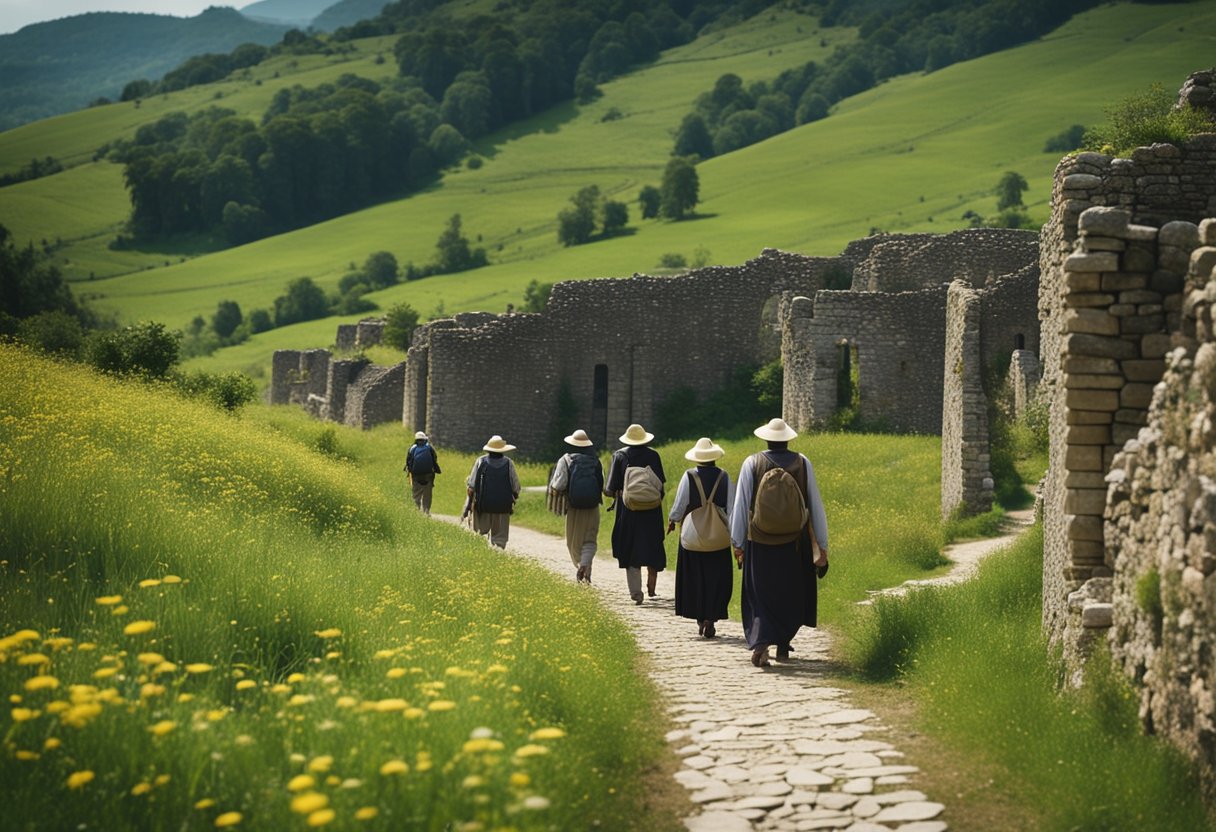
In Ireland, the intertwining of seasonal festivities and spiritual journeys has a deep-rooted history that leads thousands on paths of reflection and celebration. Here, we look at two pivotal traditions that continue to draw people into a rhythm of festivity and worship.
Lughnasadh: From Pagan Roots to Christian Adoption
Lughnasadh, traditionally beginning on the sunset of 31st July, marks the beginning of the harvest season. It honours the ancient Celtic god Lugh and involves feasting, games, and trading. Over time, Lughnasadh was embraced by Christianity, morphing into the festival of Lammas. Several pilgrimages are intertwined with this festival, notably to the summit of mountainous areas or holy wells. For instance, Lughnasadh festivals held in Ardmore, a coastal town steeped in Christian heritage, often blur the lines between the pagan and the ecclesiastical with events that appeal to a broad spectrum of spiritual seekers.
Reek Sunday: Annual Ascent
Occurring on the last Sunday of July, Reek Sunday centres around the pilgrimage to Croagh Patrick, a day steeped in penitential practice. This pilgrimage is said to be in honour of Saint Patrick, Ireland’s primary patron saint, who is believed to have fasted on the summit for forty days in the 5th century. Today, tens of thousands engage in this challenging ascent, finding community and spirituality amidst the craggy landscape. The collective energy of the climb epitomises a blend of physical endurance and spiritual intention, with individuals partaking from varied backgrounds, adding a rich tapestry to this time-honoured practice.
The Interplay of Religion and Irish Heritage
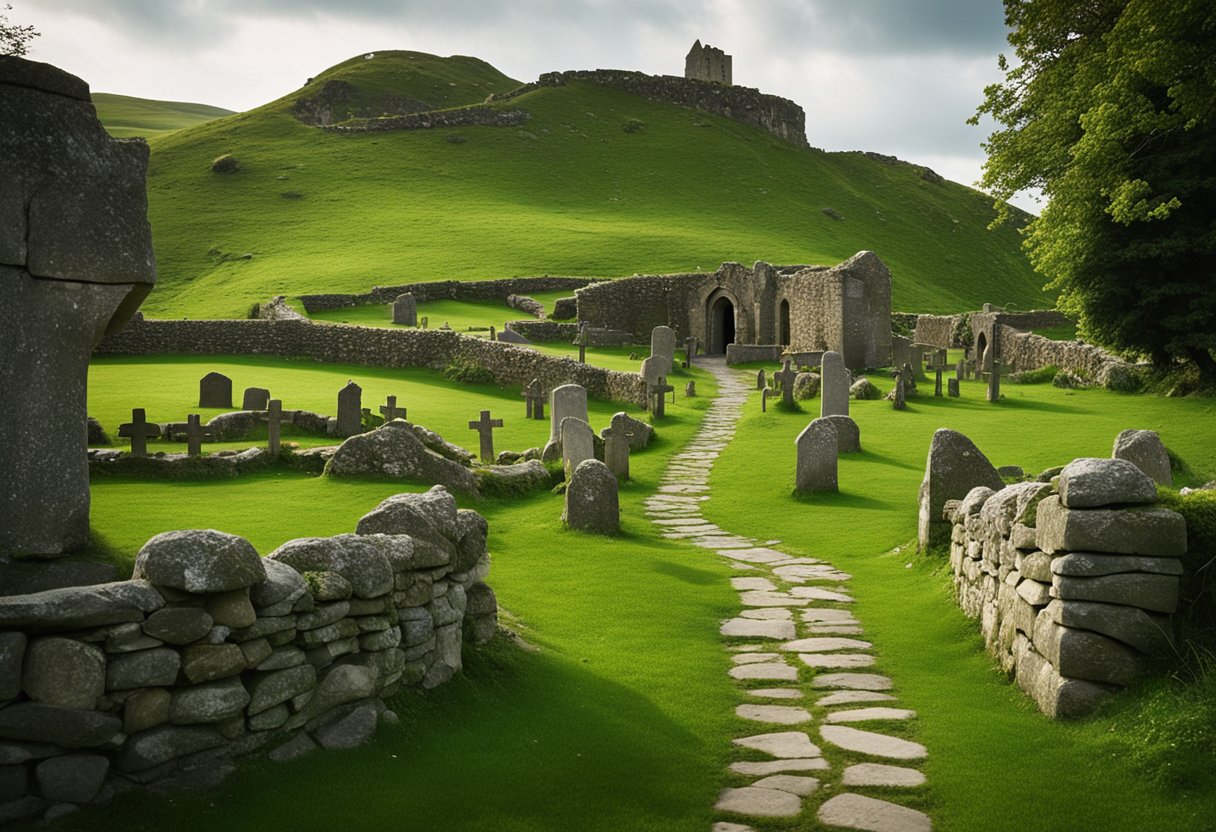
In Ireland, the synergy between religion and national heritage has crafted a landscape rich in devout pilgrimage sites infused with historical significance.
Catholicism’s Influence on Irish Pilgrimage
Ireland has a deep-seated religious tradition where Catholicism has been pivotal in shaping its cultural and pilgrimage practices. One of the most revered figures in the Irish Catholic Church is the Virgin Mary, with numerous shrines across the country dedicated to Marian worship. These sites often become focal points for pilgrimages, reflecting Mary’s significance in the spiritual life of many Irish Catholics.
A key element of this religious tapestry is St Brigid, another venerated figure whose legacy is intimately connected to the Irish land and its people. The intertwining of Brigid’s story with the pre-Christian goddess of the same name exemplifies the unique Irish capacity to blend Christian and indigenous traditions. This fusion is evident in places such as Brigid’s well in Kildare, which draws pilgrims seeking blessings and solace from this saint of fertility and protection.
The landscape of Ireland, marked by crosses and holy wells, stands as a testament to the enduring Catholic heritage. Pilgrimages in Ireland, whether they involve trekking to St Patrick’s Purgatory in Lough Derg or attending mass at Knock Shrine, are more than religious duties; they are manifestations of a cultural identity intertwined with faith.
Pilgrimage and National Identity

As we examine the profound relationship between pilgrimages and national identity, it becomes clear that these journeys are not only spiritual quests but also powerful expressions of cultural heritage and self-identity within societies, especially in Ireland.
Pilgrimage and the Irish Diaspora
The act of pilgrimage in Ireland has long been intertwined with the country’s national identity, being a tapestry interwoven with threads of faith, culture, and a connection to the land. From the emerald slopes of Croagh Patrick in County Mayo to the serene waters surrounding Our Lady’s Island in County Wexford, pilgrimages form an intrinsic part of the Irish spiritual landscape.
For the Irish diaspora, these sacred journeys offer a link back to the heart of their heritage. Cities like Cork and Derry, with their rich religious and historical significance, have become focal points for a shared identity among the dispersed Irish communities. It is within these cities and sacred sites that Irish identity is rekindled and celebrated through the collective memories and traditions of the diaspora community.
Pilgrimages also serve as a medium for the Irish worldwide to revisit and reaffirm their connection to their homeland. They celebrate identity fluidly, manifesting in both religious adherence and cultural pride. Through ritual acts like climbing the holy mountain of Croagh Patrick or partaking in the annual pilgrimages in Cork and Derry, a profound sense of belonging and Irishness is both curated and reinforced.
In essence, the paths of these pilgrimages are etched with the stories and spirituality of Ireland, calling out to the far-flung sons and daughters of the nation. They symbolize a continuity of belief and a shared essence of Irishness that transcends the physical locality, a communal tapestry that binds the Irish people together at home and abroad.
Preservation of Pilgrimage Traditions
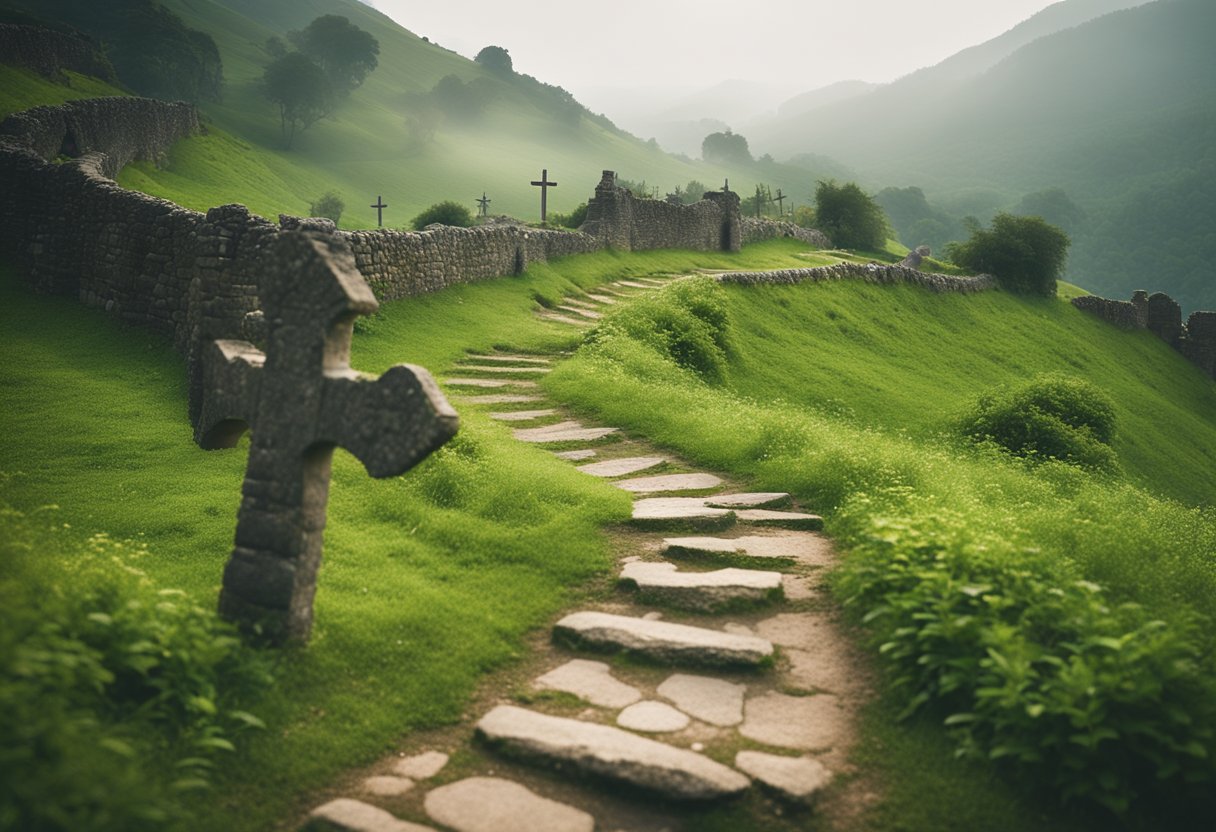
In our shared commitment to cultural heritage preservation, we recognise the importance of pilgrimage traditions in Ireland and beyond. These ancient practices offer a window into the past, allowing a continued appreciation for the spiritual journeys once embarked upon by many.
The Pilgrim Paths of Ireland, a network of ancient routes, plays a pivotal role in maintaining this sacred heritage. As custodians of our past, we actively encourage walking these pilgrim paths. Doing so not only revitalises the traditions but also deepens our understanding of the historical significance of such journeys.
| Pilgrim Paths of Ireland | Noteworthy Features |
|---|---|
| Tochar Phádraig | Connecting to Croagh Patrick |
| St. Finbarr’s Way | Leading to Gougane Barra |
| St. Kevin’s Way | Terminating at Glendalough |
The routes are lined with potent symbols of devotion, such as the high cross. For instance, the Clonmacnoise site harbours such crosses and remains a testament to the merging of art, devotion, and craftsmanship, all elements crucial to preserving our spiritual heritage.
Local communities and heritage groups devote their efforts to conserving these heritage trails. Whether through organized walks, informative signage, or route maintenance, these efforts ensure that the tradition of pilgrimage remains alive for future generations.
Our role is to continue to tread these paths thoughtfully, honouring the landscapes and monuments serving pilgrims throughout the ages. In doing so, we preserve the physical trail and the intangible essence of pilgrimage—the sense of continuity and connection to those who walked before us.
Global Pilgrimage Perspectives
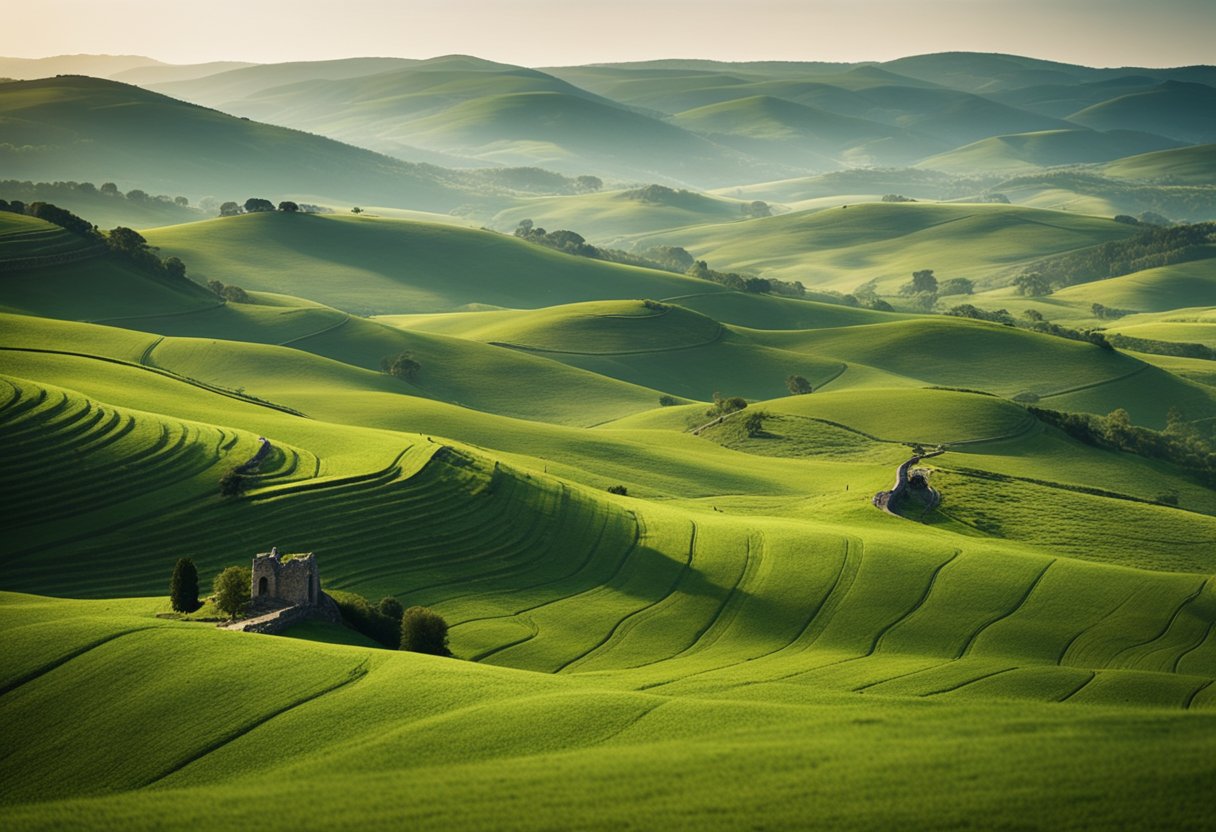
Pilgrimage transcends borders and cultures, playing a pivotal role in spiritual practice worldwide. In this interconnected landscape, Ireland is both influenced by and influenced by the global context of sacred travel.
Influences from Abroad
Our exploration of global pilgrimage landscapes reveals a tape of influences weaving across continents. For instance, with its profound historical struggles, South Africa has been a destination where spiritual journeys intersect with reflections on humanity and reconciliation. Similarly, China has significantly contributed to the pilgrimage narrative, enriched by its deep spiritual traditions and sites like Mount Tai, which are recognised as World Heritage sites for their religious significance.
Ireland’s Contribution to Global Spirituality
Ireland’s offerings to the world’s spiritual tapestry are manifold. On the one hand, prestigious institutions like Trinity College serve as beacons of knowledge, treasuring ancient texts that narrate tales of pilgrimage in eras past. Moreover, Ireland’s spiritual ethos is deeply interwoven with spirituality, which imbues the landscape with a profound sense of sacred presence evident in its pilgrim paths. These contributions enrich the global dialogue, resonating with pilgrims far and wide.
Frequently Asked Questions
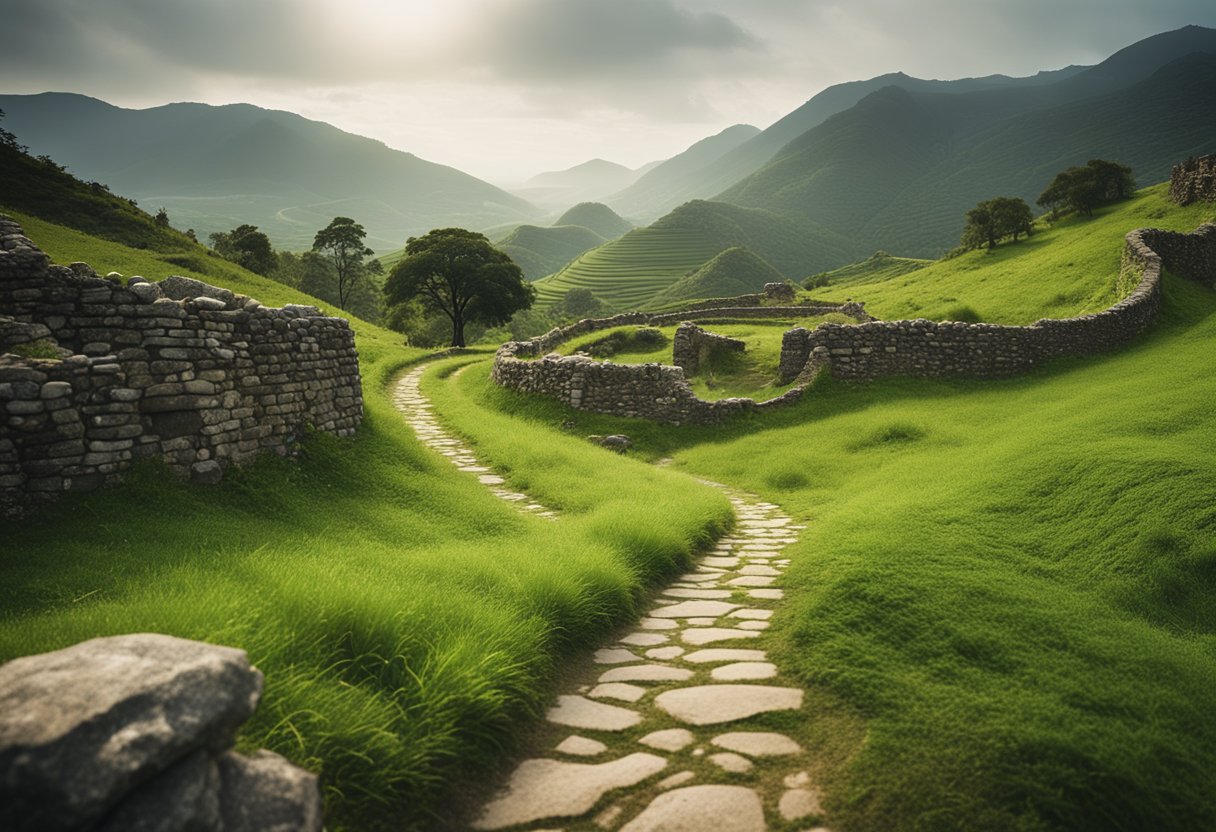
In exploring the spiritual heart of Ireland’s landscapes, we often encounter a number of questions regarding the pilgrimage journey. From the significance of historic paths to understanding traditional practices, these queries help provide a deeper insight into the pilgrim experience on the Emerald Isle.
What are the top pilgrimage sites in Ireland for spiritual journeys?
Ireland is home to various spiritual sites, from the majestic Cliffs of Moher to the serene Glendalough Valley. Pilgrims often visit the impressive lunar landscape of The Burren or traverse the historic St. Declan’s Way, connecting the Rock of Cashel to Ardmore.
How does one embark on a pilgrimage in Ireland, and what should be expected?
To embark on a pilgrimage in Ireland, one simply chooses a path with personal significance or historical importance. Expect a journey that combines natural beauty with moments of reflection, and be prepared to walk routes that have been travelled by countless others seeking spiritual insight.
What are the traditional practices involved in Ireland’s pilgrimages?
Traditional practices on Irish pilgrimages include walking the ancient paths, often whilst praying or reflecting. These routes hold centuries-old rituals, such as circling specific stones or wells, which are thought to bring blessings and healing.
Can the Irish Camino experience be likened to the Camino de Santiago, and in what ways?
The Irish Camino experience is similar to the Camino de Santiago in that it involves a series of walking routes leading to sacred sites. Like the Camino, it offers a blend of physical challenge, spiritual enrichment, and cultural immersion.
What significance does Croagh Patrick hold for pilgrims in Ireland?
Croagh Patrick, known as ‘The Reek,’ is a site of penance and pilgrimage of great significance. Thousands climb the mountain each year on Reek Sunday in honour of Saint Patrick, who famously fasted at its summit for forty days.
How many official pilgrim paths are recognised in Ireland, and what are their historical origins?
There are a number of official pilgrim paths recognised in Ireland, each with historical origins dating back centuries. These paths, detailed by organisations like Beyond These Shores, reflect the country’s rich spiritual history and have been travelled by devout pilgrims and historical figures alike.






